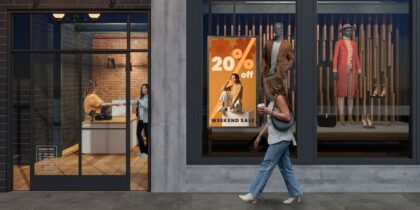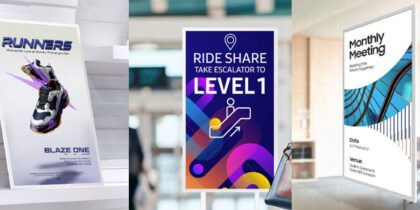In just a few years, shopping has undergone a revolution. With digital options exploding in number, it’s increasingly important for small businesses to take advantage of technology to keep up in the market. This starts with a full embrace of the digital world — and the features people love about it. Rather than seeing the digital and physical as separate, it’s time to focus on integrating them.
Retail digital signage is an effective tool to blend the digital world with the brick-and-mortar environment and create a more seamless journey for customers. The latest generations, such as Samsung displays, can do far more than just flash static ads. When matched with loyalty programs, content management systems, geolocation and other digital assets, they can achieve the frictionless, personalized experience that shoppers have come to expect today. This drives engagement, boosts loyalty and increases return on investment (ROI).
Here’s how digital displays can help small business retailers thrive.
Personalized shopping experiences that drive sales
As data-driven marketing becomes more sophisticated, shoppers expect high levels of convenience and personalization. That goes for small businesses, too. Retailers that step up to meet these expectations by supplying data-driven, personalized offers are seeing growth in basket size, upsells and ROI. This requires not just the hardware but also the software. In-store digital signage with a robust and dynamic content management system (CMS) is the key to success.
How digitizing retail experiences boosts ROI
Explore customer behavior with and the operational benefits of a complete digital retail ecosystem. Download Now
Samsung VXT, an innovative, cloud-based CMS, enables small businesses to easily create, schedule, manage and monitor content specifically for digital signage, improving outcomes. For example, with VXT Canvas, retailers can create custom content tailored to specific brands, promotions, events and even weather to drive sales. Software partner Sprinklr offers yet another platform to do the same on Samsung displays. Another feature shows the displays connected to each event and the success or failure of each screen, helping managers assess performance and strategy.
The graphic element adds more options to make a visual impact and target attention. In addition to thousands of fonts, templates and preloaded images, users can upload their retail media and VXT Art (sold separately) to apply more than 10,000 pieces of content from world-class art museums and galleries — often an ideal pairing for luxury brands.
Batteries Plus, a consumer electronics chain, offers an example of how digital signage integrated with VXT can enhance ROI. The company uses Samsung 4K UHD LED displays as “silent salespeople” to promote products triggered by real-time weather alerts.
Self-service capabilities for faster transactions
In retail, fast, frictionless transactions are the goal, which helps explain why so many consumers prefer self-serve technologies. In fact, Salesforce’s 2024 State of the AI Connected Customer report shows that 61% prefer self-service for simple issues. Its State of Service report shows the impact of self-service on success, with 80% of high-performing service organizations providing a self-service option. These perspectives make digital kiosks a particularly powerful upselling and cross-selling tool.
Samsung Kiosk allows businesses to implement self-serve technology quickly and easily. The intuitive, interactive kiosk boasts an all-in-one ordering and payment system that accepts cash, credit cards and contactless solutions such as barcodes, QR codes and near-field communication for digital wallets.
For restaurants in particular, Samsung Kiosk can come preinstalled with GRUBBRR proprietary restaurant management software, or other menu platforms like Bite, PAR or Nanonation. Using AI and machine learning, the system knows how to daypart and feature more popular or profitable items higher on the digital menu board. As at Batteries Plus, restaurants can connect products with weather events, promoting soup or hot chocolate on a cold day and ice cream and slushies on a scorching one. Self-checkouts also never forget to upsell, which increases profit-building activity and ROI. And partners like PopID simplify ordering and make transactions even smoother with easy kiosk login.
Lucrative loyalty programs
Another way retailers can increase wallet share is by integrating in-store technologies with lucrative loyalty programs. That pays off quickly. Research from the 2024 Achieving Customer Amazement study noted that 81% of customers prefer companies offering personalized experiences. That perception of improved customer service significantly impacts business, as the same report noted that 85% of customers will go out of their way to go to a company with better customer service.
The personalization that Samsung digital displays and software enables transfers to loyalty programs. When customers feel like a business knows them and understands their purchasing patterns, they will likely stay loyal to that business. Samsung Kiosk partners with loyalty programs like Punchh to help achieve this through consumer data collection. Using these insights, brands can create and deploy customized, hyper-personalized loyalty campaigns that convert customers and increase basket sizes.
Fast adaptation to customer and market needs
Digital signage allows retailers to adapt messaging and promotions in real time to customer behavior, inventory levels, emerging trends, market shifts and other variables. For example, restaurants can quickly add and remove items from menu boards. During the holidays, stores could also customize displays to feature the season’s trending gifts.
Speed is essential, too, and a key benefit of Samsung displays. Businesses can change content quickly and easily, be it updating pricing, displaying new products or promoting limited-time offers. Additionally, interactive digital displays can provide customers with valuable extra information that just might inspire conversion. This could include product details, reviews and recommendations.
One novel way retailers can respond to customer and market needs is through traffic analysis. By incorporating solutions like FastSensor, which leverages AI and heat mapping to gather and analyze foot traffic data, retailers can quickly adapt to customer needs by managing queues and determining which in-store marketing messages work — and which don’t.
Samsung Kiosk models perfectly complement this. The kiosks come in three installation types — floor stand, countertop, and wall-mounting — which allow them to fit into a wider range of spaces within the traffic flow. Their sleek, modular, space-saving design and gray-white color blend in with practically any aesthetic, too.
The digital future of retail
As the retail landscape evolves, businesses that embrace small business technology will be able to provide enhanced customer experiences and reap the ROI rewards of digital transformation. The tangible returns on investment in cost savings, revenue growth and customer engagement make a compelling case for retailers to make Samsung displays and end-to-end solutions an integral part of their business strategy.
Sign up for a VXT free trial. Explore Samsung’s wide selection of digital signage and commercial displays and how they can help drive retail traffic and sales.








